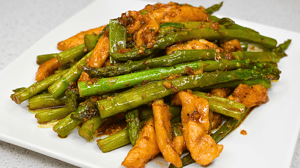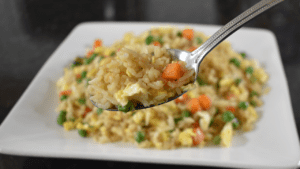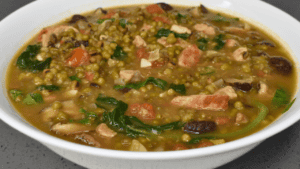Steamed Eggs
Steamed eggs, also known as egg custard or chawanmushi are made by mixing beaten eggs with liquid (usually water or broth) and then cooking them gently over low heat until they are set.

Mastering the Art of Deliciously Delicate Steamed Eggs
In the culinary world, there’s a dish that’s light yet fulfilling. It traverses cultures with ease, finding a place in kitchens from the East to the West. We’re talking about steamed eggs—a dish as versatile as it is simple. For home cooks looking to expand their repertoire, understanding steamed eggs might just be the delightful culinary adventure you need.
A Brief History and Versatility of Steamed Eggs
Steamed eggs have an illustrious history. Originating from Asian cuisines, particularly Chinese and Japanese, these silky custards have been a staple for generations. Known as “chawanmushi” in Japan or simply egg custard in China, steamed eggs are celebrated for their simplicity and comfort.
What makes them truly special is their adaptability. You can savor them for breakfast, lunch, or dinner. Dress them up with savory toppings, or keep them plain for simplicity’s sake. The possibilities are endless, which is why they hold such allure for home cooks eager to explore.
Health Benefits of Steamed Eggs
Not only are steamed eggs delicious, but they’re also packed with nutritional benefits. Eggs, the primary ingredient, are a powerhouse of protein, essential vitamins, and minerals. They provide a balanced source of energy that’s perfect for starting your day or as a light meal.
Steaming, as a cooking method, helps retain these nutritional elements. Unlike frying, which can add unnecessary fats, steaming preserves the integrity of the ingredients. This ensures that you’re enjoying a dish that’s not only tasty but beneficial for maintaining a balanced diet. Home cooks can rest easy knowing they’re serving up nutrients with every dish.
How to Make Perfect Steamed Eggs
Creating the perfect steamed eggs requires a gentle touch and attention to detail. Here’s a step-by-step guide to get you started:
- Ingredients and Preparation:
- 4 large eggs
- 1 cup of water
- ¼ tsp salt
- 1 tsp sesame oil
- 1 tsp soy sauce
Begin by cracking the eggs into a measuring cup. Add the water and salt, then gently beat the mixture with a fork or whisk. This ensures a smooth consistency.
- Steaming Process:
Fill a pot with water and place a rack inside. Set a shallow bowl on the rack, then pour the egg mixture into the bowl through a strainer. Cover the bowl tightly with foil to prevent water from entering.
- Cooking and Finishing:
Cover the pot with a lid and cook over medium-low heat for 15 minutes. Once cooked, turn off the heat and carefully remove the bowl from the pot. Allow it to cool for 5 minutes before drizzling with sesame oil and soy sauce for additional flavor.
These steps ensure a perfectly smooth and tender texture, making your steamed eggs a triumph in any meal.
Tips for Home Cooks
For those new to steamed eggs, here are some tips to enhance your cooking experience:
- Choosing the Right Equipment:
A steamer or a pot with a rack works best. Ensure the lid fits snugly to maintain consistent steam throughout the cooking process.
- Sourcing Quality Eggs:
Fresh eggs are vital for the best flavor and texture. Opt for organic or free-range where possible, as they often have a richer taste.
- Troubleshooting Common Issues:
If your eggs are too runny, try extending the cooking time slightly. For a smoother texture, ensure the egg mixture is well-beaten and strained before steaming.
With these insights, even novice home cooks can make steamed eggs to perfection.
Steamed Eggs Around the World
Steamed eggs are not confined to Asian cuisine. They take on different forms and flavors across the globe:
- Korean Gyeran-jjim:
Known for its fluffy texture, this version often includes vegetables and seafood, creating a delightful mix of flavors.
- French Oeufs Cocotte:
A more decadent take, featuring cream and topped with herbs or cheese, providing a luxurious start to any meal.
- Thai Kai Toon:
Often spiced with fish sauce and garnished with green onions, offering a savory twist that’s both aromatic and satisfying.
These variations showcase the global appeal of steamed eggs, proving their versatility and ability to adapt to various cultural palates.
Conclusions on Steamed Eggs
In closing, steamed eggs are a culinary gem that offers simplicity and versatility. They are a nutritious choice that fits seamlessly into any meal plan. Whether you’re an experienced chef or a home cook beginning your culinary journey, steamed eggs are an excellent dish to master.
Take the plunge and try your hand at making steamed eggs. Experiment with different flavors and ingredients, and share your creations with friends and family. The joy of cooking lies in exploration, and steamed eggs offer a perfect canvas for creativity.
Frequently Asked Questions
How long does it take to steam eggs?
Typically, steaming eggs takes about 15 minutes. This can vary slightly depending on the heat source and the size of the eggs, but 15 minutes is a good benchmark for a perfectly set custard.
Is it better to steam or boil eggs?
Both methods have their merits. Steaming is often preferred for making delicate dishes like egg custard, as it provides a gentler cooking environment that enhances texture. Boiling, on the other hand, is quick and suitable for hard or soft-boiled eggs.
Are steamed eggs healthy?
Yes, steamed eggs are healthy. They retain more nutrients compared to frying, and they offer a balanced mix of protein and essential vitamins without added fats from cooking oils.
Can you steam an egg in a frying pan?
Yes, with a bit of creativity! Use a lid to trap steam within the pan. Keep the heat low and add a small amount of water to create steam. This method can mimic the steaming process, though results may vary slightly.
With these insights, you’re well-equipped to enjoy the art and simplicity of steamed eggs in your own kitchen. Happy cooking!

Steamed Eggs
Ingredients
- 4 large eggs
- 1 cup water
- ¼ tsp salt
- 1 tsp sesame oil
- 1 tsp soy sauce
Instructions
- Crack the eggs into a measuring cup.
- Add water and salt, then gently beat the mixture with a fork or whisk.
- Fill a pot with water and place a rack inside. Set a shallow bowl on the rack, then pour the egg mixture into the bowl through a strainer. Cover the bowl tightly with foil.
- Cover the pot with a lid and cook over medium-low heat for 15 minutes.
- Once cooked, turn off the heat and remove the bowl from the pot. Allow it to cool for 5 minutes.
- For an added touch of elegance, drizzle sesame oil and soy sauce on top.





















